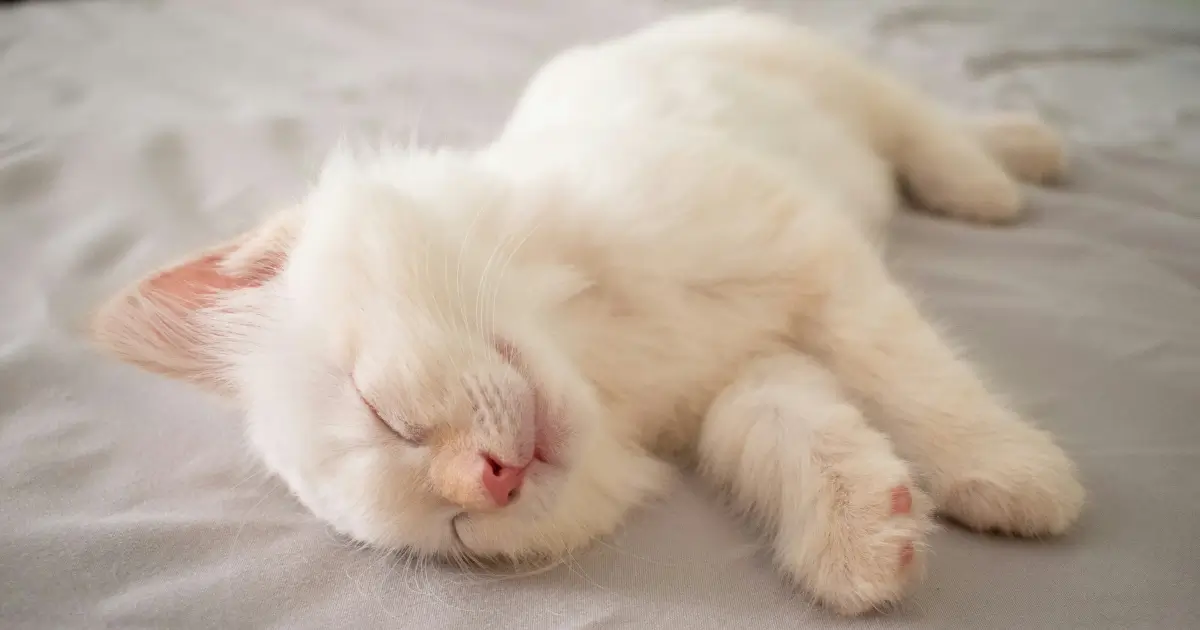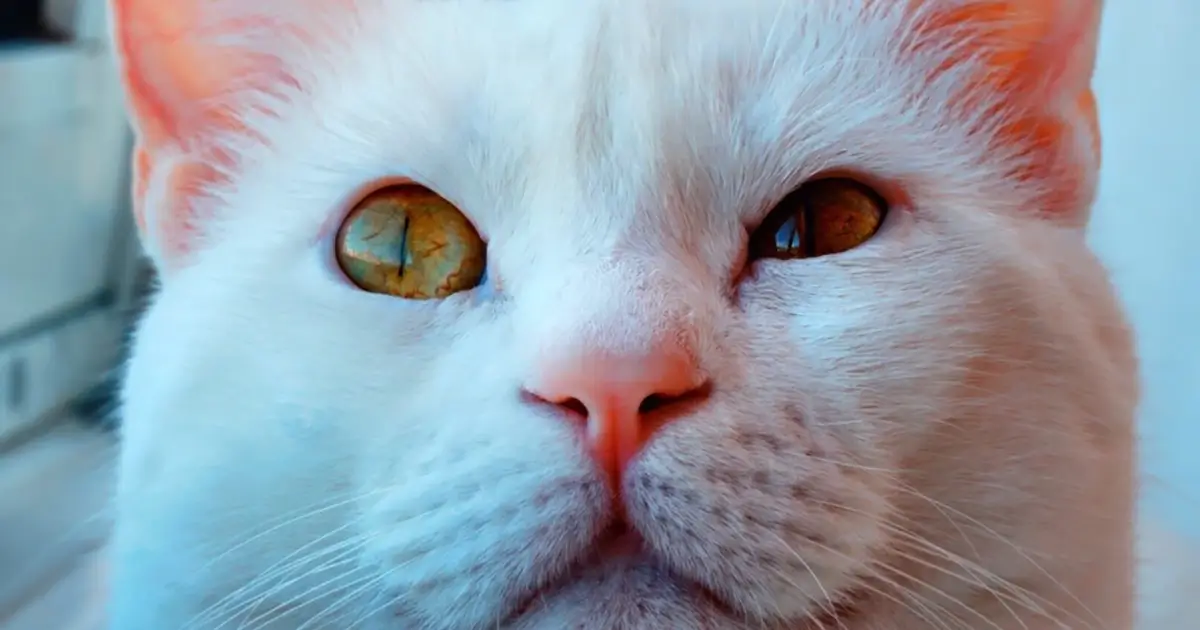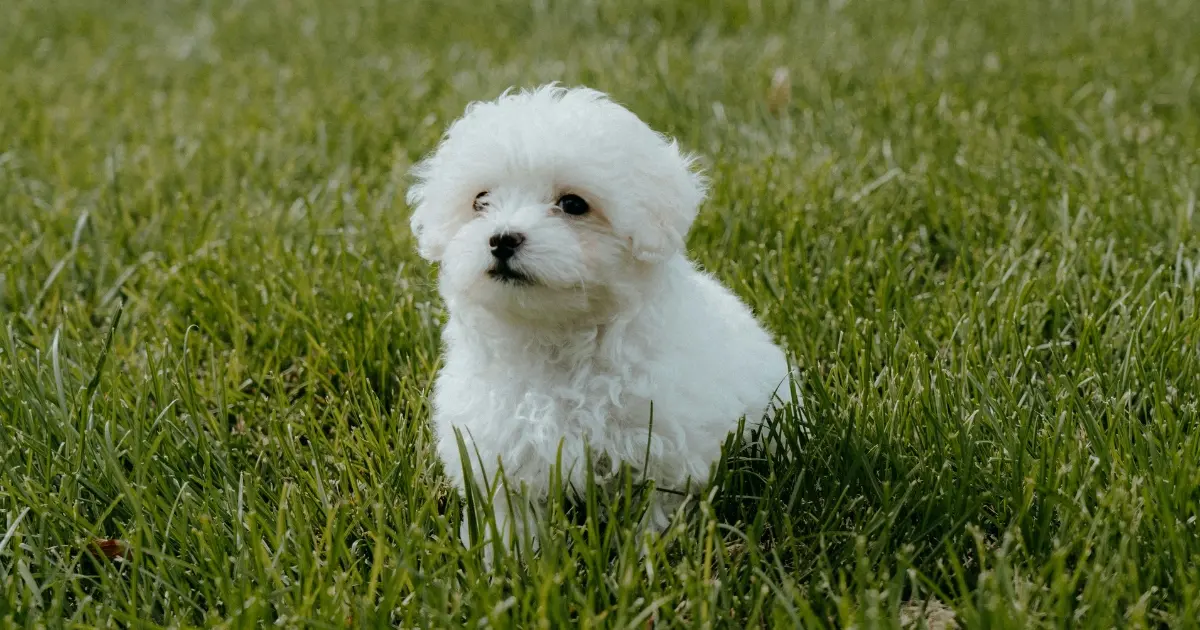Cat zoomies are a fun and puzzling sight for many pet owners in the United States. These sudden energy bursts turn calm cats into fast-moving whirlwinds. They zoom through homes at incredible speeds.
During cat zoomies, cats show off their wild side with fast sprints, wild jumps, and random circles. These bursts of energy often surprise and intrigue their owners. It makes them wonder what causes these sudden outbursts.
To understand why cats get zoomies, we need to look at several factors. These include their natural instincts, physical health, and what’s happening around them. Whether your cat is young or old, these energy bursts are usually normal. They show how complex and interesting feline psychology can be.
Vets and animal experts say zoomies are important for cats. They help cats release built-up energy, practice hunting, and stay physically and mentally healthy. Seeing these behaviors as natural helps us appreciate our cats’ special ways of communicating.
This article will explore the science, behaviors, and triggers behind cat zoomies. We’ll uncover the reasons behind these fun and mysterious energy bursts in cats.
Table of Contents
Understanding the Phenomenon of Cat Zoomies
Cat owners often find themselves puzzled when their feline friends suddenly burst into high-energy episodes. These episodes, known as “zoomies,” are a fascinating aspect of cat behavior. Many wonder why do cats get the zoomies.
Defining Sudden Energy Bursts in Cats
Zoomies are rapid, intense periods of explosive energy. Cats appear to run around like a maniac. They might dash from room to room, leap on furniture, and display seemingly random bursts of movement.
These episodes typically last a few minutes. They can happen without any apparent trigger.
Common Behaviors During Zoomie Episodes
- Rapid, unpredictable running
- Sudden changes in direction
- Tail puffing and arching
- Playful pouncing
- Intense eye movements
When Zoomies Typically Occur
Cat owners might notice their pet randomly appear on our pouch and start an unexpected zoomie session. These energy bursts often happen:
- After using the litter box
- Early morning or late evening
- Following a period of rest
- During moments of perceived excitement
“Zoomies are a natural expression of feline energy and playfulness,” says veterinary behaviorist Dr. Sarah Thompson.
Understanding these energetic episodes can help cat owners appreciate their pet’s natural instincts. It also helps provide appropriate mental and physical stimulation.
Why Do Cats Get Zoomies: The Science Behind Feline Energy Bursts
Cats are full of mystery and fascinating behavior. As someone who works with cats, I’ve seen their random excitement bursts. These bursts puzzle even the most experienced pet owners.
Zoomies are a natural instinct for domestic cats. They come from their wild ancestors’ survival strategies. Seeing how fast a housecat can run during these episodes shows their amazing athleticism.
- Neurological triggers stimulate rapid movement
- Pent-up energy seeks immediate release
- Instinctive hunting behaviors manifest spontaneously
Feline zoomies are more than playful behavior—they show cats’ complex biological programming. These energy bursts last from 30 seconds to a few minutes. During this time, cats show incredible speed and agility.
“Cats’ sudden energy bursts are a testament to their evolutionary heritage and complex nervous system.” – Dr. Sarah Mitchell, Feline Behavior Specialist
Veterinary research shows these bursts have many purposes. They help cats keep their muscles toned, release stress, and practice survival skills like stalking and chasing.
Natural Instincts and Evolutionary Reasons for Zoomies
Cat zoomies are more than just random bursts of energy. They’re deeply rooted in feline evolutionary behaviors that have survived from their wild ancestors. A running cat isn’t simply playing—it’s expressing complex instincts that once meant survival in the wilderness.
Cats carry genetic memories of hunting strategies that trigger sudden energy releases. These zoomie episodes mimic predatory movements, allowing domesticated cats to practice critical survival skills.
Hunting Behavior Correlation
The connection between zoomies and hunting instincts is fascinating. When a bagel cat appears to dart unexpectedly across the room, it’s practicing:
- Stalking techniques
- Pouncing movements
- Rapid acceleration skills
Territorial Marking During Zoomies
Howling cats at night often use zoomies as a method of territorial communication. Their rapid movements spread scent markers and signal their presence to potential competitors.
Energy Release Patterns
Domestic cats retain wild hunting patterns. These energy bursts help them:
- Maintain physical fitness
- Reduce stress
- Practice natural movement skills
“Zoomies are not just play—they’re a window into a cat’s wild heritage.”
The Role of Age in Cat Zoomies Behavior
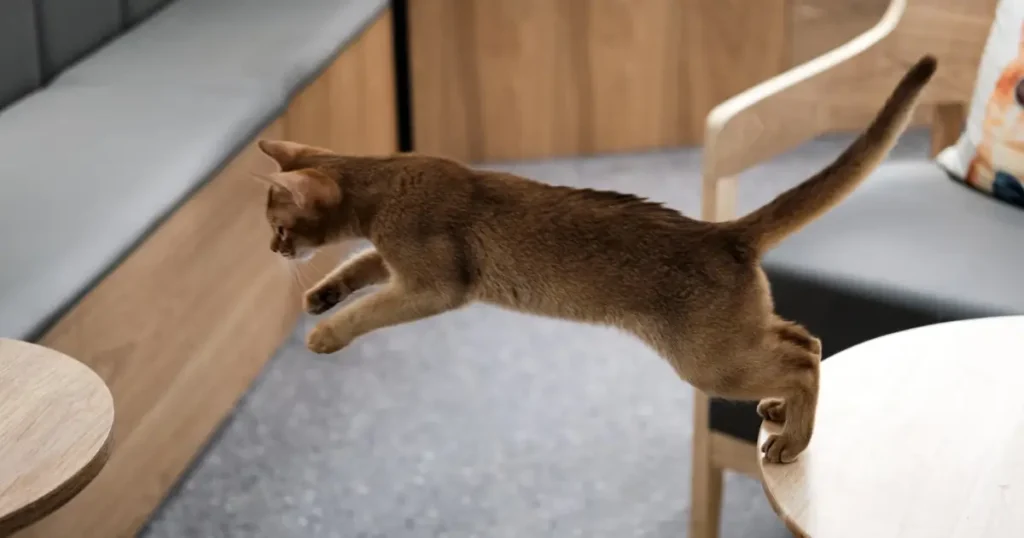
Cat zoomies change as cats grow older. Kittens are full of energy and can be very active. They often leave their owners trying to calm them down.
Young cats have zoomies more often and more intensely than older cats. This is important for kitten owners to know. It helps them understand why their kittens might be so active.
- Kitten Stage (0-6 months): Most energetic period with frequent zoomies
- Young Adult (6-24 months): High activity but more controlled bursts
- Adult Cats (2-7 years): Occasional zoomies, more predictable patterns
- Senior Cats (8+ years): Reduced frequency and intensity of zoomies
When a kitten ignores you, it’s because they love to play and explore. Their zoomies help them stay physically and mentally active. This is especially true when they’re young.
“Zoomies are a natural expression of feline energy, varying dramatically with age and individual personality.” – Veterinary Behavior Specialist
To manage zoomies, give your kitten the right play spaces and toys. Also, teach them to listen with consistent training. This helps use their energy in a good way.
Environmental Triggers That Spark Zoomie Episodes
Cats are very sensitive to their surroundings. Knowing what sparks zoomies can help pet owners understand their cat’s energy bursts.
Indoor vs Outdoor Environments
Energy levels in cats change a lot between indoors and outdoors. Indoor cats often zoom around more because they have less space and fewer things to do. They might suddenly run fast in the house to get rid of extra energy.
- Indoor cats usually zoom more often
- Outdoor cats can use natural exploration to release energy
- Less space means more sudden energy bursts
Time of Day Impact
Many cat owners wonder why their cat zooms around at certain times. Cats are most active at dawn and dusk, when they naturally want to hunt. These times usually make zoomies more intense.
Weather and Seasonal Influences
Seasonal changes really affect cat behavior. In colder months, cats might zoom around more to stay warm and fight boredom indoors.
“Cats use zoomies as a natural mechanism to regulate their energy and respond to environmental stimuli.” – Feline Behavior Experts
- Rainy days make indoor zoomies more common
- Summer heat can make cats less active
- Seasonal changes affect cat energy levels
By knowing these environmental triggers, cat owners can better handle their pet’s zoomie episodes.
Physical and Mental Health Benefits of Zoomies
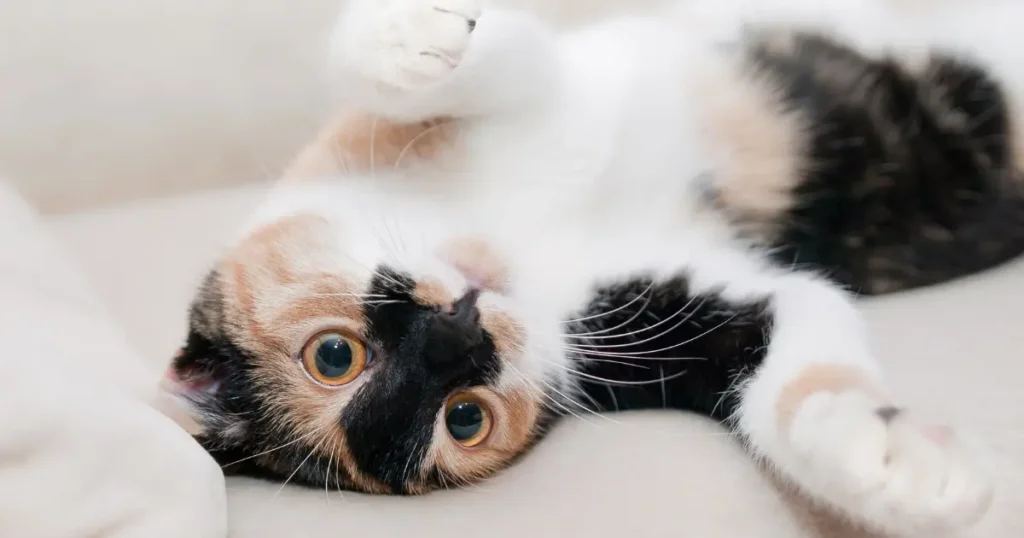
Cat zoomies are more than just random bursts of energy. These playful episodes offer big health benefits for our feline friends. When cats meow while playing with toys, they’re doing something very important for their fitness and wellness.
Zoomies do more than just entertain. They help cats stay in top shape by:
- Improving muscle tone and flexibility
- Boosting cardiovascular health
- Releasing pent-up energy
Mentally, zoomies are very important. During these energetic moments, cats get to relax and feel better emotionally. These play sessions help keep boredom and anxiety away, making cats happier overall.
“Zoomies are nature’s way of keeping cats physically fit and mentally sharp.” – Veterinary Behavior Specialist
Seeing zoomies often means a cat is healthy and happy. These moments let indoor cats act out their natural hunting instincts. It keeps their athletic skills sharp.
- Enhanced muscle strength
- Mental stimulation
- Stress reduction
By understanding and encouraging these bursts of energy, cat owners can help their pets stay healthy and happy.
When Cat Zoomies Might Signal Health Issues
Cat owners often wonder why their cat is acting weird during sudden energy bursts. While zoomies are typically normal, they can sometimes indicate underlying health concerns that require closer attention.
Understanding the difference between typical and problematic zoomie behavior is crucial for responsible pet care. My cat is acting strange might not always mean something serious, but certain signs warrant veterinary investigation.
Distinguishing Normal vs Concerning Behavior
Normal zoomies typically last a few minutes and occur occasionally. Signs that might indicate a health issue include:
- Excessive frequency of zoomie episodes
- Zoomies accompanied by vocalization or apparent distress
- Sudden behavioral changes during energy bursts
- Uncoordinated movements or disorientation
Signs That Warrant Veterinary Attention
If you’re wondering what does the cat access counter do on meowzing and notice any of these symptoms, consult a veterinarian:
- Persistent zoomies that interrupt normal daily activities
- Zoomies followed by hiding or apparent pain
- Neurological symptoms during energy bursts
- Sudden onset of frequent, intense zoomie episodes
“Unusual zoomie behavior could be your cat’s way of communicating a health concern.”
Professional veterinary evaluation can help rule out potential medical conditions and ensure your cat’s well-being.
Managing and Supporting Healthy Zoomie Behavior
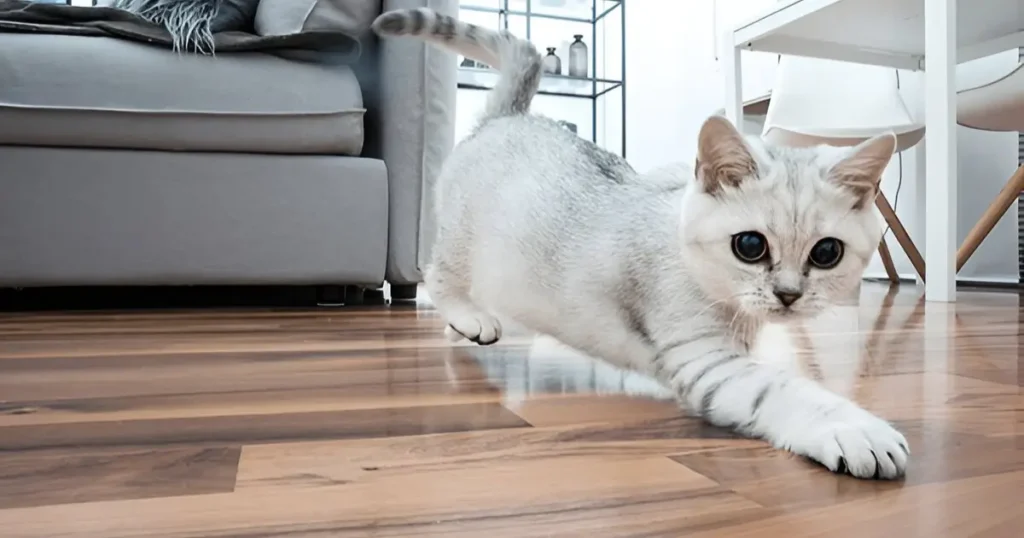
Cat zoomies are a natural part of a cat’s life. They can sometimes be overwhelming for pet owners. It’s important to know how to manage these bursts of energy for your cat’s health and your home’s peace.
Cats get zoomies to release built-up energy. With the right steps, you can help them enjoy their natural behaviors.
To keep cat zoomies in check and create a balanced home, try these tips:
- Schedule regular interactive play sessions
- Provide engaging toys that mimic hunting experiences
- Create vertical spaces like cat trees and shelves
- Use puzzle feeders to stimulate mental engagement
Pet owners looking to stop cattery cycles should focus on keeping their cats mentally and physically active. Interactive play is key to redirecting zoomie energy into positive outlets. Spend 10-15 minutes twice a day playing with wand toys, laser pointers, or interactive electronic toys.
“A tired cat is a well-behaved cat” – Veterinary Behaviorist Recommendation
Knowing your cat’s energy patterns is key to managing zoomies. Some cats need more stimulation than others. Watch and adjust your approach as needed.
- Recognize your cat’s unique energy rhythms
- Create predictable play and rest schedules
- Use environmental enrichment strategies
By using these techniques, you’ll help your cat stay healthy and reduce zoomie disruptions.
Creating a Safe Environment for Cat Zoomies
Cat zoomies can turn your home into a fun playground. Cats get zoomies after pooping or suddenly, needing a safe place to play. This keeps them from getting hurt.
To keep your cat safe during zoomies, you need to plan and prepare carefully.
Cat-Proofing Your Living Space
Make a safe area for zoomies by removing dangers. Cats might crash or bump into things when they get zoomies. This is because of their sudden energy and meowing.
- Remove fragile decorative items from low shelves
- Secure loose electrical cords
- Clear pathways of obstacles
- Use soft floor coverings in play areas
Designing Appropriate Play Areas
Having special play areas helps manage zoomies. If your kitten cries at night, a play zone can help. It’s a great way to release energy.
- Choose areas with soft flooring
- Install cat trees and scratching posts
- Create vertical spaces for climbing
- Use interactive toys to channel energy
“A well-designed environment transforms zoomies from potential chaos to joyful play.” – Feline Behavior Experts
By following these tips, you’ll make a safe and fun space for your cat. It will support their natural behavior and energy release.
The Connection Between Diet and Zoomie Episodes
Cat owners often wonder why their pets suddenly become midnight racers. Diet is key to understanding zoomies and managing energy levels.
Nutritional factors greatly affect a cat’s behavior, especially with screaming at night or constant meowing. The right diet can help control your cat’s energy and reduce nighttime activity.
- High-protein diets support natural energy cycles
- Balanced meals prevent sudden energy spikes
- Proper nutritional timing can help stop cat from meowing at night
“A well-planned diet is key to managing your cat’s energy levels and reducing disruptive behaviors.” – Veterinary Nutrition Expert
Cats need specific nutrients that affect their activity. Complex carbohydrates and lean proteins help keep energy stable day and night.
Here are some dietary strategies for managing zoomies:
- Feed smaller, more frequent meals
- Choose high-quality protein sources
- Avoid late-night feeding that might trigger nighttime activity
- Incorporate interactive feeding techniques
Talking to a vet can help find the right diet for your cat’s needs and energy.
Conclusion
Cat zoomies are a fascinating and normal behavior that shows the complex world of our feline friends. These sudden bursts of energy are not just random running. They are deeply rooted in cats’ instincts, providing them with physical and mental stimulation.
Exploring why cats have zoomies reveals a rich tapestry of natural behaviors. From marking territory to releasing energy, these intense episodes show cats’ wild ancestry. Understanding cat zoomies helps pet owners create safe spaces that support their cats’ natural impulses.
Cat zoomies are more than just playful moments. They are essential for feline health. These energetic outbursts serve multiple purposes, from physical to mental. By recognizing and supporting these behaviors, cat owners can build happier, healthier relationships with their pets.
Pet parents should see zoomies cats as a sign of vitality and emotional well-being. Providing play spaces, interactive toys, and mental stimulation can help channel this energy. With the right understanding and care, cat zoomies can be a joyful part of feline companionship.
FAQ
What exactly are cat zoomies?
Cat zoomies are when cats suddenly run fast around the house. They dart from room to room quickly. These short bursts of energy can include running, jumping, and erratic movements.
Are zoomies normal for cats?
Yes, zoomies are normal and healthy for cats. They help cats release energy, exercise, and show their playful side. Most cats, especially young ones, experience zoomies.
Why do cats get zoomies after using the litter box?
Cats get zoomies after using the litter box due to instinct. In the wild, they run away to avoid predators and hide their scent. This instinct leads to sudden energy and excitement in domestic cats.
Do older cats get zoomies too?
Older cats can still get zoomies, but it’s less common. Their zoomies are usually shorter and less frequent than those of younger cats.
How can I help manage my cat’s zoomies?
To manage zoomies, play with your cat often and use interactive toys. Provide vertical spaces like cat trees. Make sure your cat gets enough physical and mental stimulation. Regular play can help reduce zoomie episodes.
Are zoomies a sign of a medical problem?
Zoomies are usually normal, but changes could mean a health issue. If your cat’s zoomies are different or accompanied by other symptoms, see a vet.
Do indoor cats get zoomies more often than outdoor cats?
Indoor cats get zoomies more often because they have less chance to release energy. Without hunting or exploring, they have more energy that bursts out in zoomies.
Can diet affect my cat’s zoomie behavior?
Diet can affect a cat’s energy. A balanced diet can help regulate energy and reduce zoomies. Talk to your vet about the best diet for your cat.
Why do cats sometimes yowl during zoomies?
Cats may yowl during zoomies as a way to express excitement and energy. It’s a form of communication or an instinctual response to their energy burst.
Are zoomies more common in certain cat breeds?
Some breeds, like Abyssinians, Bengals, and Siamese, tend to have more zoomies. But, individual energy levels can vary within any breed.


